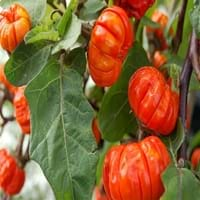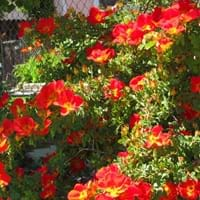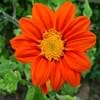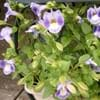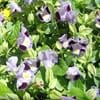Life Span
Annual
Perennial
Type
Tree
Flowering Plants, Ornamental Plants, Shrubs
Origin
Middle Africa
Not Available
Types
Not Available
Not Available
Number of Varieties
Not Available
Habitat
Moist Soils
Foot Hills
USDA Hardiness Zone
3-9
Not Available
AHS Heat Zone
12 - 1
Not Available
Sunset Zone
H1, H2, 1a, 1b, 2a, 2b, 3a, 3b, 4, 5, 6, 7, 8, 9, 10, 11, 12, 13, 14, 15, 16, 17, 19, 20, 21, 22, 23, 24
Not Available
Habit
Upright/Erect
Clump-Forming
Flower Color
White
Orange Red, Yellow
Flower Color Modifier
Bicolor
Bicolor
Fruit Color
Orange, Gold, Orange Red
Non Fruiting Plant
Leaf Color in Spring
Green, Light Green
Green
Leaf Color in Summer
Green, Light Green
Green, Dark Green
Leaf Color in Fall
Green, Yellow green
Dark Green
Leaf Color in Winter
Light Green
Dark Green
Leaf Shape
imparipinnate
Pinnate
Plant Season
Summer, Fall
Spring, Summer, Fall
Sunlight
Full Sun, Partial Sun
Full Sun, Partial Sun
Type of Soil
Loam
Loam, Sand
The pH of Soil
Acidic, Neutral
Acidic, Neutral
Soil Drainage
Well drained
Well drained
Bloom Time
Summer
Spring, Late Spring, Early Summer, Summer, Late Summer, Early Fall, Fall
Repeat Bloomer
Yes
Not Available
Tolerances
Drought
Drought
Where to Plant?
Ground
Container, Ground, Pot
How to Plant?
Seedlings
Cuttings
Plant Maintenance
Medium
Medium
Watering Requirements
Requires a lot of watering
Average Water Needs
In Summer
Lots of watering
Lots of watering
In Spring
Moderate
Moderate
In Winter
Average Water
Average Water
Soil pH
Neutral
Acidic, Neutral
Soil Type
Clay
Loam, Sand
Soil Drainage Capacity
Rich
Well drained
Sun Exposure
Full Sun
Full Sun, Partial Sun
Pruning
Remove damaged leaves, Remove dead branches, Remove dead leaves
Remove damaged leaves, Remove dead branches, Remove dead leaves
Fertilizers
All-Purpose Liquid Fertilizer
All-Purpose Liquid Fertilizer
Pests and Diseases
Red blotch
Beetles, Black Spot, Caterpillars, Downy mildew, Mosaic viruses, Powdery mildew, Rust, Scale insects, Thripes
Plant Tolerance
Drought
Drought
Flowers
Insignificant
Showy
Flower Petal Number
Single
Double
Edible Fruit
Yes
Not Available
Foliage Texture
Coarse
Medium
Foliage Sheen
Matte
Glossy
Invasive
No
Not Available
Self-Sowing
Yes
Not Available
Attracts
Birds
Birds, Butterflies
Allergy
Not Available
Rash
Aesthetic Uses
Not Available
Showy Purposes
Beauty Benefits
Not Available
Not Available
Environmental Uses
Air purification
Air purification
Medicinal Uses
Anti-oxidant, Digestive, Fiber, Minerals
Not Available
Part of Plant Used
Flowers, Fruits, Leaves, Seeds
Flowers
Other Uses
Animal Feed, For making oil, Used as a nutritious food item
Oil is used in perfume, soaps, creams, etc.
Used As Indoor Plant
No
Yes
Used As Outdoor Plant
Yes
Yes
Garden Design
Fruit Tree
Container, Cutflower, Feature Plant, Foundation, Mixed Border, Topiary / Bonsai / Espalier
Botanical Name
SOLANUM integrifolium
Rosa foetida
Common Name
Chinese Scarlet Eggplant, Pumpkin Tree, Turkish Eggplant, Turkish Orange Eggplant
Austrian briar, Persian yellow rose, Austrian copper rose
In Hindi
कद्दू पेड़
Austrian copper rose
In German
Kürbis-Baum
Die Gelbe Rose, Fuchs-Rose, Wachs-Rose, Persische Gold-Rose, Austrian Briar
In French
arbre de citrouille
Le rosier fétide
In Spanish
árbol de calabaza
Rosa foetida
In Greek
δέντρο κολοκύθας
Austrian copper rose
In Portuguese
árvore abóbora
Rosa fétida
In Polish
drzewa dyni
Róża żółta
In Latin
PEPO ligno
Austrian copper rose
Phylum
Magnoliophyta
Magnoliophyta
Class
Magnoliopsida
Magnoliopsida
Order
Scrophulariales
Rosales
Clade
Not Available
Not Available
Tribe
Not Available
Not Available
Subfamily
Not Available
Not Available
Number of Species
Not Available
Properties of Pumpkin Tree and Austrian Copper Rose
Wondering what are the properties of Pumpkin Tree and Austrian Copper Rose? We provide you with everything About Pumpkin Tree and Austrian Copper Rose. Pumpkin Tree has thorns and Austrian Copper Rose doesn't have thorns. Also Pumpkin Tree does not have fragrant flowers. Pumpkin Tree has allergic reactions like Not Available and Austrian Copper Rose has allergic reactions like Not Available. Compare all the properties and characteristics of these two plants. Find out which of these plant can be used as indoor plant. If you are interested to decorate your house and garden, find out aesthetic uses, compare them and select the plant which will beautify your surrounding. Along with beautification, try comparing medicinal and edible uses of Pumpkin Tree and Austrian Copper Rose and you can choose the plant having best and most benefits.
Season and Care of Pumpkin Tree and Austrian Copper Rose
Season and care of Pumpkin Tree and Austrian Copper Rose is important to know. While considering everything about Pumpkin Tree and Austrian Copper Rose Care, growing season is an essential factor. Pumpkin Tree season is Summer and Fall and Austrian Copper Rose season is Summer and Fall. The type of soil for Pumpkin Tree is Loam and for Austrian Copper Rose is Loam, Sand while the PH of soil for Pumpkin Tree is Acidic, Neutral and for Austrian Copper Rose is Acidic, Neutral.
Pumpkin Tree and Austrian Copper Rose Physical Information
Pumpkin Tree and Austrian Copper Rose physical information is very important for comparison. Pumpkin Tree height is 90.00 cm and width 90.00 cm whereas Austrian Copper Rose height is 150.00 cm and width 170.00 cm. The color specification of Pumpkin Tree and Austrian Copper Rose are as follows:
Pumpkin Tree flower color: White
Pumpkin Tree leaf color: Green and Light Green
Austrian Copper Rose flower color: Orange Red and Yellow
- Austrian Copper Rose leaf color: Green
Care of Pumpkin Tree and Austrian Copper Rose
Care of Pumpkin Tree and Austrian Copper Rose include pruning, fertilizers, watering etc. Pumpkin Tree pruning is done Remove damaged leaves, Remove dead branches and Remove dead leaves and Austrian Copper Rose pruning is done Remove damaged leaves, Remove dead branches and Remove dead leaves. In summer Pumpkin Tree needs Lots of watering and in winter, it needs Average Water. Whereas, in summer Austrian Copper Rose needs Lots of watering and in winter, it needs Average Water.
